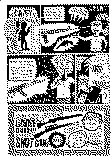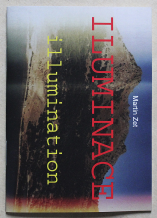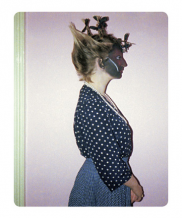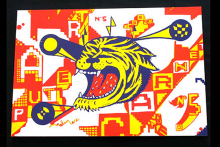| Revista Umělec 2001/1 >> Mad Reality | Lista de todas las ediciones | ||||||||||||
|
|||||||||||||
Mad RealityRevista Umělec 2001/101.01.2001 Ludmila Vachtová | Teoría | en cs |
|||||||||||||
|
Hypermental, Curated by Bice Curiger, Kunsthaus Zürich, 17 November 2000 – 21 January 2001, Hamburger Kunsthalle, 16 February – 5 May 2001 “Hypermental” swooshed over the sharp-angled facade of the Kunsthaus in Zürich. Curator Bice Curiger, internationally noted for her excellent exhibitions, came up with this ambiguous neologism for the end of the millenium and it provided shelter for everything imaginable, from cosmic tales to cocaine-induced artificial paradises. Subtitled Mad Reality, the exhibition Hypermental attracted 25,000 visitors to the gallery. “Get out of my mind. Immediately leave this space,” roared Bruce Nauman unequivocally from a darkened box near the entrance, but of course nobody was dissuaded from entering. Together they demonstrated the principle that the more absurd a refusal is, the stronger the desire is to disregard it. The broader the offered associations, the easier it is to abuse them. The show provided a plethora of individual realities to choose from, and each one was just a little bit unhinged. Bice Curiger was able to span these insights with the callous lightness of touch that is typical in cultural activity today. As the editor-in-chief of the influential magazine Parkett, she is an expert on several international art scenes (unfortunately not the Czech one) and a practical theorist. She frequents studios in preference to academic offices, and she knows that the current generation of artists considers historical analysis, and the entire theory of socially-determined causality, to be Stone Age. While it was evident that many of the young big-timers knew nothing about André Breton and the rules behind surrealist plays, nonetheless they had intuitively taken these structures on as their own, sometimes distorting them, other times using them with innocent insatiability. But they always did so without relating to an ideological background. This is not a case of the programmed resurrection of a former doctrine but of identification with the “protosurrealist moment” encoded in human existence. The 20th century in the end followed its own path and the so-called great narratives fizzled out, but though the terms have changed, the feeling has remained the same. In fact, feeling is almost all that remains, so that while no one would think of having a theoretical debate on sexuality and sadomasochism, everyone knows how to broaden the mind by snorting cocaine. Scholarly quarrels about the esthetic advantages of abstraction or figuration here failed to raise even a sympathetic smirk. All the taboos have been transgressed and at a time of emphasized virtuality, art has discovered its own artificial body. Hypermental is just everything that exceeds a norm. Mad reality is born in the head and typically settles around you in the everyday, in the kitchen, in bed, on the highway, distantly reminding us of a phenomenon our forefathers Smidras — Bedřich Dlouhý and Karel Nepraš — once called “strangeness.” It inspires neither terror nor fear but something seductive in between, accompanied by light chills on the scruff of the neck and inordinate curiosity that blurs the difference between reason and consequence, between the offender and the victim. It was this mood of curious, unrestrained transgression that Bice Curiger set out to explore. In order to realize her illusion, she selected 50 allies of various ages and specializations, ranging from Salvador Dalí and Jeff Koons to Olaf Breuning and Louise Bourgeois. Her stock crew, teamed here with a solid assembly of guests, is clearly willing to assume any role: Robert Gober, Mariko Mori, Damien Hirst, and Cindy Sherman — all of whom appeared in Miracles and Marvels — seem to take part in all of her productions. Curiger assigned participants to six loosely structured, overlapping themes. They paid no attention to “linear development” or formal tendencies, and it was perhaps unsurprising that the chapter on eroticism was the most convincing: It’s everywhere. Honorable art historians raised eyebrows and accused the errant curator of creating chaos in her disregard for the recommended order. How could she not when she was going hypermental? She intentionally stripped the works of protective esthetic categorization. She set them free onto the museum floor, where more entertaining meetings took place than that of “an umbrella and a sewing machine on a surgery table” as recommended by historical surrealists. Pipilotti Rist, obsessed with the idea of the dapper lad, wandered through a gigantic supermarket, illustrating the advantages of video. Armed with a sword, radio and cardboard armor, Olaf Breuning battled his own dreams. Doug Aitken scattered sand and invoked heat. Louise Bourgeois’ shirt and collar happily copulated together while Cindy Sherman this time did black and white smut, which charmingly complemented Eric Fischl’s masturbation ceremony. Damien Hirst took pleasure in the head of a corpse and Matthew Barney was, as usual, megacool with his strange gen-technology. The theme could have been serious, but cheerful ease abounded in the gallery as if the whole thing was a huge global party. Everybody looked as if they knew each other, they exchanged greetings and banal pleasantries as if through habit. They left no traces. The swarm of works was vast but nothing really happened and, most noticeably, nothing hurt. To experience the amassed images was like browsing the Internet. Everything changes in just a wink. Rejoice. Originally, the exhibition was supposed to be at the Rudolfinum Gallery in Prague. The two parties — Bice Curiger and the Rudolfinum’s Petr Nedoma — gave entirely different explanations as to why they didn’t cooperate in the end. One more reason to reconcile yourself to the idea that every reality is in the end deceptive and fallacious. Translated by Vladan Šír
01.01.2001
Artículos recomendados
|
|||||||||||||
|
04.02.2020 10:17
Letošní 50. ročník Art Basel přilákal celkem 93 000 návštěvníků a sběratelů z 80 zemí světa. 290 prémiových galerií představilo umělecká díla od počátku 20. století až po současnost. Hlavní sektor přehlídky, tradičně v prvním patře výstavního prostoru, představil 232 předních galerií z celého světa nabízející umění nejvyšší kvality. Veletrh ukázal vzestupný trend prodeje prostřednictvím galerií jak soukromým sbírkám, tak i institucím. Kromě hlavního veletrhu stály za návštěvu i ty přidružené: Volta, Liste a Photo Basel, k tomu doprovodné programy a výstavy v místních institucích, které kvalitou daleko přesahují hranice města tj. Kunsthalle Basel, Kunstmuseum, Tinguely muzeum nebo Fondation Beyeler.
|
































 New book by I.M.Jirous in English at our online bookshop.
New book by I.M.Jirous in English at our online bookshop.
Comentarios
Actualmente no hay comentariosAgregar nuevo comentario